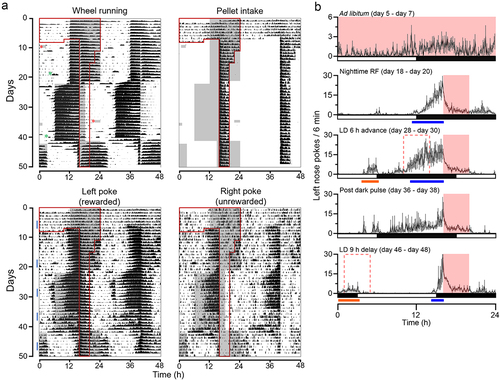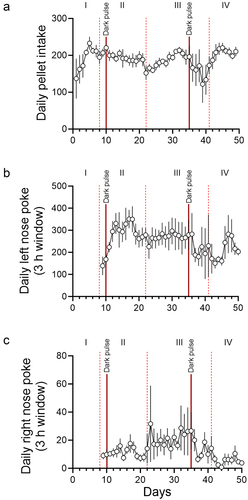Figures & data
Figure 1. Food availability time is encoded to the light-entrainable circadian oscillator. (A) Average double-plotted ethograms for wheel running activity, pellet intake, left (rewarded) nose pokes, and right (unrewarded) nose pokes, recorded from C57BL/6N male mice (n = 5). Data was plotted percentile plot in 6 min bins, quantiles of 50. Individual ethograms of all male mice are shown in Figure S1. On the left half of the double-plotted ethograms, night (dark) is indicated as grey shading, and the time of food availability is outlined in red lines. Due to a technical issue (forced Windows update), the mice received two incidental dark pulses, a 2 h dark pulse at the beginning of day 9 and a 3.5 h dark pulse in the middle of the day on day 35. These are indicated with red asterisks in the Wheel Running subpanel. This incidence did not affect the data collection by FED3, as it is battery-operated. Cage changes are indicated by green asterisks. (B) Group average 24-h profiles of the left nose pokes of 3 days during ad libitum (day 5 – day 7), 3 days during night-time restricted feeding (day 18 – day 20), 3 days during the period after the light-dark cycle was advanced (day 28 – day 30), 3 days immediately after the incidental dark pulse (day 36 – day 38), and 3 days during the period after the light-dark cycle was delayed (day 46 – day 48). The time of food availability is indicated by the solid pink box. The pink dotted box indicates the time of food availability if it were linked to the phase of the light-entrainable oscillator. Data are presented as mean ±SEM. Blue bars indicate bouts of food anticipatory poking for current mealtime. Orange bars indicate bouts of phase-shifted food anticipatory poking for previous mealtime.

Figure 2. Daily changes in pellet intake, anticipatory rewarded left nose pokes, and anticipatory unrewarded right nose pokes. Daily pellet intake (pellets/day; A), anticipatory rewarded left nose pokes 3 h before the feeding schedule (pokes/3 h window; B), and anticipatory unrewarded right nose pokes 3 h before the feeding schedule (pokes/3 h window; C) are shown. The days in which light schedules were changed are indicated with vertical dotted lines. The days when incidental dark pulses were given to the mice are indicated with solid red lines. Roman numerals (I: ad libitum feeding, II: nighttime restricted feeding, III: 6 h light-dark cycle advance, IV: 9 h light-dark cycle delay). Data are presented as mean ±SEM (n = 5).

Supplemental Material
Download MS Word (1.3 MB)Data availability statement
Data reported in this paper is available upon request.
